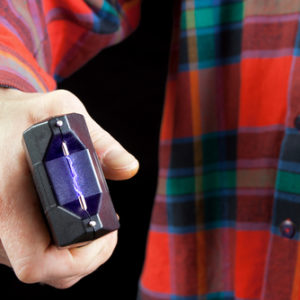Currently Browsing: client
Feb 14, 2019
Posted by John Stagner on Feb 14, 2019 in client | 0 comments
It started innocently enough for Simon Bunce. In 1999, he applied for a credit card through a major supermarket. He began making benign purchases online for everyday things, like all of us.
Fast forward five years to 2004, when he was surprised by police on his doorstep in the UK – with a search warrant. He was promptly handcuffed and put into jail.
Although he was innocent of any wrongdoing, he was accused of being a pedophile, his family disowned him, his computers and drives were seized, he lost his job, and his life was ruined.
The real perpetrator was safely tucked away in Indonesia – over 7,000 miles away. He had stolen Bunce’s credit card info during a cyber attack on the supermarket, then used that info to purchase child pornography.
It’s one of the most chilling tales of identity theft imaginable and illustrates how cybercrime can go far beyond financial ruin.
Types of Cyber Attacks
Although there are many types of cyber attacks, the individual stories hit closest to home for most of us. But we should all be concerned about cyber threats on business because the potential of exposing customers multiplies exponentially.
If you are an owner, partner or other principal in a business, it can open you up to staggering liabilities. While this article only touches the surface, knowing where the risks lie is a crucial first step in preventing them.
In no particular order, here are five of the most common cyber attack examples:
#1 – Malware
One of the largest ‘categories’ of cyber attacks is Malware. Malware can be loosely defined as malicious software that is covertly deployed onto a computer, server or network.
It qualifies as its own category because there are so many forms it can take. It can self-deploy, replicate itself, hide, infect, disguise, and destroy. Some of those forms include the following:
- Software or Macro Viruses. These viruses themselves to software applications, then replicate themselves when the program is opened, attaching to code elsewhere in the system.
- Trojans. Just like the hollow wooden horse used in Greek history, this malware is disguised to look like something else, like a useful program. Inside, however, a sinister plot awaits to open a gate and allow the invaders to enter.
- Worms. Have you ever heard of the planarium worm? It’s a flatworm that, when cut into pieces, each piece will completely regenerate into a whole worm. Unlike viruses, worms don’t attach to files but are self-contained, and commonly propagate through email, creating copies of itself and infecting entire systems.
- Boot-Record Viruses. These viruses are activated when a computer starts up, loads itself into memory, then begins infecting any connected computer or drive.
- Ransomware. Almost a category all by itself, ransomware is one of the most dangerous types of malware. It essentially ties up data and holds it hostage until you pay up. That’s right – you give us money, and we’ll let you have access to your files so you can continue doing business. There is a distinction between malware and ransomware, based on what the hacker intends to do. Small businesses are a major target because they are the most likely to give in to the demands of the hackers, often with devastating financial consequences.
#2 – Phishing Attacks
Phishing attacks are just what they sound like – a bad guy putting some bait out there on a hook to see if you’ll bite. The bait is designed to look like something you want or something you can trust. One of the most common phishing attacks is an email designed to look like it’s from a trusted source – like your bank or credit card company. The goal is to get you to click on a link and ‘verify’ (hand over) personal information. It’s often under the guise of some security threat that needs to be addressed.
#3 – DOS/DDOS Attacks
Denial of Service, or Distributed Denial of Service attacks are meant to create so much traffic on a server or website that it can’t function properly. Imagine a congested highway in the city at rush hour. That’s what happens to your system in a DOS/DDOS attack. Sometimes these attacks are carried out simply for malice or revenge, but it’s also a perfect scenario to demand payment from the victim.
#4 – SQL Attacks
Pronounced ‘sequel,’ the SQL attack stands for Structured Query Language. It is an attack on a database of records. Much like a master hypnotist, it asks seemingly innocent questions, or queries, to gain access to more information.
Every time you enter a username and password and hit enter, the system ‘queries’ a database to find a matching record, then lets you in if you gave it the right answers.
By exploiting weaknesses in the computer language used, hackers can get the system to return the whole enchilada – all the records available in the database.
#5 – Passwords
It might surprise you to know that the average business employee has 191 passwords to keep track of. Let that sink in for a moment. Given that the majority of
people use the same or similar passwords on multiple sites, it’s not surprising that 81% of data breaches happen because of passwords.
The emerging use of two-factor authentication has helped to squelch the problem, but it’s still epidemic.
The Hidden Effects
Often, we think about cyber threats as ‘merely’ financial, but the costs are far-reaching. Remember our innocent victim Simon Bunce? His story wasn’t about money at all – at least not in the beginning. But the dominoes eventually fell in just about every way they could.
To get an idea of the multiplying effect of a data breach in business, consider this: Over the next five years, 146 billion records will fall into the wrong hands.
That’s nearly 20 times the world’s current population.
The extended risks of cyber attacks on business include damage to reputation, lost customers, unrecoverable records, employee ID vulnerability, and legal liability. The list goes on.
The Bottom Line
With so many types of cyber attacks on the rise, you can’t bury your head in the sand and expect to survive. You must recognize them and be proactive – before something happens.
Aside from education on all fronts in your organization, using technology to protect technology is a good place to start. XXXXXXX uses some of the most sophisticated IT security protocols available to keep your company safe. Check out our blog for additional helpful IT security articles.
John Stagner is a Father, Husband, Favorite Sibling, and Freelance Writer from Salem, Missouri.
Feb 14, 2019
Posted by John Stagner on Feb 14, 2019 in client | 0 comments
If you’ve ever been curious about the effectiveness of stun guns, you’re not alone. But you might also be surprised to know how many of your friends are carrying this non-lethal self-defense tool. They are easy to get, affordable, and currently legal to own just about everywhere in the U.S.
As of January 2019, stun guns are illegal in only three states and restricted in five others (meaning you need a license in those states). Details on that below.
In any of the unrestricted states, you can go to just about any gun show and find a vendor selling stun guns, pepper sprays, personal alarms, and self-defense items.
If you do a google search, you’ll get dozens of seller links in the blink of an eye. More gun shops are beginning to stock them as well. But there’s nothing quite like getting your hands on one in person and hearing that jolting SNAP of the arc when you squeeze the trigger.
In this article, you’ll learn everything you need to know about the different types, legality, features, and best of all—how to use them.
Stun Guns vs. Tasers
There’s a difference between the stun gun and the Taser. Taser is a bit of a misnomer because the latter refers to Taser International—the company who manufactures a specific brand. It has become a common name for a device that could fire the electrodes out of the device, making it effective for targets up to 15 feet away.
Both fall into the category of electroshock devices, but the Taser was first developed by a NASA scientist in 1969. It originally used gun powder to fire the electrodes.
The main difference between the two is distance. The Taser device fires the electrodes but they remain attached by wires attached to the battery. The Taser device doesn’t require the weapon to make direct contact with the target. Police grade Tasers can fire up to 30 feet away, where civilian models are typically good only up to 15 feet.
The other big difference is pulsation. The stun gun has a trigger or switch that must be continuously pressed. The Taser device has a pulsating effect where it delivers the shock repeatedly and repeats the cycle for up to 30 seconds.
The Taser device disrupts the central nervous system, while the stun gun is designed to cause localized pain.
For civilians, stun guns are the more popular choice—mainly because of the price. Small, handheld stun guns are available starting at around $20, while Tasers are often upwards of $1,000 to start.
Are Stun Guns Legal?
If you’re in law enforcement, it’s not even a question. Stun guns and Tasers are legal in all 50 states. If you are a civilian, however, it’s a different story in some places.
The list has changed dramatically in the last several years, in favor of making them legal to carry in most places. They are legal in 47 states, but not in Hawaii, New York, and Rhode Island.
In addition, some states like Illinois require a concealed-carry permit or firearms license to own a stun gun. Currently, the other restricted states include Connecticut, Iowa, Michigan, and Wisconsin.
Certain metropolitan areas also either have a restriction, or prohibit them entirely. Washington, D.C. and Annapolis, MD have banned them entirely.
In any case, because the laws are always subject to change, it’s a good idea to check with local law enforcement in your area before purchasing a stun gun or carrying one openly.
And before you get on a plane, check restrictions on where you’re going before you board. Electroshock devices are generally allowed in checked baggage, but not carry-on.
Stun Gun Features and Types
There is an impressive variety of stun guns available on the market. Many of them come as a stun gun and flashlight combo. Some of the more popular types are:
Batons: These come in many sizes, shapes, and materials. Many of the steel batons have a knobby end, useful for breaking glass, or as a club to be used against an attacker. The flashlight on some models is multi-mode: a flashlight, sometimes in three brightness levels, an SOS mode, and a strobe mode to momentarily confuse the attacker.
Other batons have electrode strips along the sides, in case the attacker attempts to take it away from you.
Stun Rings: Made to be completely concealed in your palm, a stun ring looks like a ring on your finger. The body of the device is hidden, and a quick squeeze activates the shock.
Disguised: These are meant to deceive your attacker, increasing the element of surprise. Among the types masquerading as common objects: Lipstick, cell phones, keychains, and flashlights.
A favorite among older people is the stun cane. Disguised as an ordinary walking cane, this model does more than act like a cattle prod. Many are equipped with additional electrodes around the lower 12-18 inches. If an attacker tries to grab the cane, a quick squeeze of the trigger will change his mind.
An important feature to look for is a disable pin. These are usually attached to a wrist strap. The idea is to have the strap around your wrist, and if your attacker manages to take your stun gun away, the disable pin attached to your wrist strap disables the device. At best, all your attacker has now is a non-shocking flashlight.
Voltage and Current
There is significant debate about the voltage, amperage and other ratings of stun guns. The reality is that most of the debate is irrelevant. Here’s what you need to know.
Many sources say that the manufacturers greatly exaggerate the voltage of stun guns because there’s no effective way to measure it. This is true, to a degree. But it can be calculated, based on the output capacity of the battery source and number of turns in the coil.
The most common analogy used in the electrical field to understand electricity is to compare it to a water system. Voltage is like the amount of water pressure the pump can deliver. Think of it as “pushing power.”
Current is represented by water flow, and how much of it. Pressure alone does nothing until water flows. How much water flows depends on how much pressure is pushing it. In the same way, voltage does nothing until current flows. It’s the flowing water that does the work, and it’s the current that does the work to shock an attacker.
A third important factor in this example is the size of the hose. With a higher pressure (smaller hose), you’ll have less water, but it can squirt farther from the end of the hose. In a stun gun, the higher voltage (pressure) allows electricity to jump farther, but you won’t have as much current (flow) because of the higher resistance (smaller hose).
So what does it all mean? The voltage/current discussion can be boiled down in a very simplistic way to this. Higher voltage may give an arc the ability to jump farther, or to go through more clothing than a lower voltage. The current that flows into the attacker is what matters, and it’s regulated to be no more than 5 mA (5/1000ths of one Ampere).
A sustained current over 5 mA flowing through a human can be lethal, but there are many other factors at play. Every person has different resistance, and some have a higher tolerance than others.
How to Use a Stun Gun
Again, opinions may vary on the best way to use a stun gun for self-defense, but most experts will agree on a few key points.
First things first. If your attacker has a gun, and wants your money, give it to him. Real guns trump stun guns—always.
Aim for bare skin when possible. The theory is that higher voltage will jump better through clothing, but better safe than sorry. If the assailant has on a jacket, go for the neck, ears, face, or any bare skin you can find.
Press, squeeze, repeat. Drive the weapon into the attacker while squeezing the trigger and stay engaged. If they are in a position where they can move away from you, be prepared to move with them and keep driving it into them.
Maintain the shock for 4-5 seconds before releasing the trigger. Let up for only a split second, and repeat. Do this as many times as needed, while looking for an avenue of escape.
Use disorientation. The longer you deliver the shock, the greater the effect, but a second or two is not enough. The larger the attacker, the more this is true. Disorientation begins at around 4 to 5 seconds for most people. Use that disorientation to trip your attacker, gouge the eyes, call for help, etc., while looking for a way out. If you have a baton-type stun gun, you can use that in between shocks on soft targets like the face and neck.
In the end, remember that a stun gun is not a complete self-defense survival tool. It should be combined with other common-sense ways to stay safe.
John Stagner is a Father, Husband, Favorite Sibling, and Freelance Writer from Salem, Missouri.
Feb 14, 2019
Posted by John Stagner on Feb 14, 2019 in client | 0 comments
Tradeshows are a mini-vacation for some. It’s a time to get away, network with other people in your industry, make new friends, and promote your business. For other vendors, tradeshows are simply a way of life because it’s the lifeblood of their business.
No matter which category you fall into, you must take trade show security into consideration. If you don’t, all that fun can go away in a moment because of one little security slip. You forgot to lock a display case. You were careless with trade secrets lying out in the open. Or perhaps you trusted somebody you shouldn’t have to watch your things while you stepped away from your booth for a few minutes.
In this article, we’ll look at the who, what, when, why, and how of tradeshow theft. The “where” is already established.
Trade Shows Are a Different Animal
In many ways, trade show security has many of the same issues as any other business where valuables are left unattended overnight. Think about scrap yards, for example. They are rarely operated overnight and thieves know this. It’s a prime opportunity to sneak in and take a small fortune in copper or other valuable materials.
Construction site security is always on the minds of contractors. On larger projects, there are tens of thousands of dollars worth of tools and equipment left on-site. Even though they are often chained up or locked in trailers, it doesn’t always dissuade the most determined burglar.
But there are some things particular to tradeshows that put them into a special category. Not only do you have unattended items overnight, but the sheer volume of traffic generated also makes tradeshows and exhibits a picnic for thieves. In some ways, trade show theft is even more likely than at other businesses.
Who’s on the Take
When we talk about preventing theft from your trade show booth, most of us think about the shifty-eyed criminal walking around in a hoodie and casing all the displays. While tradeshows are a common target for criminals, you should also think about the risks from others.
Smaller, localized tradeshows often have a group of loyal vendors. Over time, they build relationships with one another and tend to be protective of the group. At larger shows, however, the risk of theft from other vendors is real.
None of us wants to think that another vendor might try to steal our stuff. But sometimes it’s not the stuff they’re after. Think corporate espionage. Depending on your industry, tradeshows and exhibits are the perfect scene for corporate spies. Make sure you think about digital property as much as physical property. You have as much responsibility to protect customer lists and trade secrets as you do company property.
What They’re After
Theft at tradeshows isn’t always the big stuff. We’ve already mentioned valuable items and corporate spying. But small items that are easily slipped into the pockets of smalltime criminals are also at risk.
Freebies and giveaways are common incentives to show visitors. We don’t often think of it as theft, but we know freeloaders are out there and they don’t mind filling their bags with your promotional items and samples. That is stuff that you paid for with your money, but it never occurs to some people that it’s not free to you.
Also, consider your trade show “hardware.” Things like tablets, smartphones, credit card swipers, and small cash boxes are often a quick and easy target to grab while you are busy with a potential customer.
When it Happens
The most obvious time to get free stuff is when you’re away from the booth. This happens during the trade show when you eat need to grab a bite to eat, visit with other vendors, or use the restroom.
The cardinal rule is this: never leave your booth unattended during the show. If you didn’t bring a partner with you who can watch your table, ask another vendor that you feel you can trust to keep an eye on things. If you go to tradeshows often, you will naturally develop relationships with other vendors. Make an effort whenever possible to get your booth located close to theirs.
There is always a big concern about nighttime security—what happens after the trade show ends for the day and before it begins the next day. You can’t always be certain about the security team at any given event, so your two best bets during this time are lock-and-key and video surveillance.
If you watch professionals—the guys going to dozens of tradeshows every year—they always keep their valuable items under lock and key. Some valuable items like guns are often in a lockable carrying case. But that’s not enough. You have to be able to prevent the entire thing from being carried off. A good deterrent is a steel cable going through all the handles of carrying cases.
A good investment is locking display cases and cabinets. Although they can be bulky, they serve two different purposes: they display your items, obviously, but also protect your items under lock and key at night or if you need to leave your booth for a few minutes during the show.
If you attend trade shows on a regular basis and have theft-worthy items, it might be good to invest in video surveillance. That way, if something happens, you have the evidence right there. An even better option is monitored video surveillance because sometimes it comes with really cool features like strobe lights when it senses motion, or even audio, where the monitoring service can speak to the would-be burglar.
Why You’re Vulnerable
Like it or not, tradeshows and exhibits are a major target for bad guys. And certain types of tradeshows are more likely to be targeted than others. Think about gun shows, were all sorts of weaponry are on display. Trade show attendees are not vetted. There are no background checks for attendees.
How to Improve Your Trade Show Security
The first ingredient in tradeshow security is common sense. To recap a few of those:
- Never leave your booth unattended.
• Keep high-value items under lock and key if possible.
• Hide trade secret items and non-display valuables out of sight.
• Have a plan to protect your things overnight.
• Form a “neighborhood watch” with other vendors that you know.
• Mis-label your boxes on purpose. On boxes with valuables, mark them as sales brochures or something else unappealing.
• Talk to other vendors to see what methods they use to safeguard their things.
• Remember that competitors can pose a security risk in certain industries.
• Talk to security staff and ask them what they see most often. Ask them for any tips that might offer.
• Consider overnight video security. Having visible video cameras with signage indicating 24 seven monitoring can be a powerful crime deterrent.
• Use GPS trackers on expensive items.
• Whenever possible, have at least one other attendant at your booth for times when you get busy with customers. Another set of eyes on merchandise can make a big difference.
• Keeping your things organized makes it easier to notice if something is wrong at a glance.
It is also important to consider security outside the trade show booth. Your valuables are also potentially exposed on your way to and from the show. Whether you have a locking trailer or exposed containers in the back of a truck, they are at risk every time you stop to fuel up, go to a restaurant, or overnight at the hotel.
Be sure to plan ahead by checking the neighborhood of the venue as well as the hotel. Talk to tradeshow hosts and any local law enforcement to inquire about the safety of those areas.
Planning is Key
in the end, one of the biggest assets you have in protecting your assets is awareness. It’s worth taking some time to think about trade show security risks before your next event. Just being aware of the risks will force you to be more alert on the floor.
The more you know about what happens inside the mind of the criminal, the better you’ll be able to throw a wrench into his plans. Talk to other vendors, the tradeshow contractor, and anyone else that might help you gain some insight.
Taking some time to think along these lines will go a long way toward helping you get a security plan together—no matter what business you’re in. It’s much better to be proactive than to be reactive.
At XXXXXXX, we specialize in monitored mobile video security. For more useful tips on securing your building, facility, or event, check out our other articles here.
If you are already involved in the security industry, why not consider partnering with us? Get more information about that on our partner page.
John Stagner is a Father, Husband, Favorite Sibling, and Freelance Writer from Salem, Missouri.
Feb 14, 2019
Posted by John Stagner on Feb 14, 2019 in client | 0 comments
Forget about Florida.
When it comes to retirement, the Pacific Northwest is where it’s at. Specifically, we’re talking about Marysville, WA. Located only 35 miles north of Seattle, Marysville (pop. 67,625) is an outdoorsman’s paradise, an extremely popular family destination, and a retiree’s dream.
Marysville has something for everyone!
Wineries and distilleries abound, along with culturally rich museums and natural habitat areas for those who like solitude. Whether you’re looking for a great place for your family to visit, or you’re a soon-to-retire professional, Marysville, WA is worth checking into.
So stoke the fire, grab your favorite drink, and join us on a virtual tour as we discover the Marysville area and its fine people.
Parks, Water, and Nature
For the outdoors type, there’s no shortage of natural beauty and outside activities for you.
If you’re a fan of water—whether it be swimming, fishing, sailing, or anything else—be prepared to be blown away! From freshwater streams and lakes to beachfront scenes and water adventures, Marysville has water galore!
Kayak Point County Park is a very popular family destination. Boasting over 3000 feet of saltwater shoreline as well as Evergreen forests, this park has it all. There’s plenty of fishing for even the most adventurous fisherman. Flounder, rockfish, sole, and walleye-pollock are just a few varieties you can reel in.
The water depth at the end of the pier can get as deep as 50 feet during high tide.
The park has a whopping 40 acres dedicated only to recreation. Plenty of picnic shelters and a playground make this a fantastic family destination. It also offers overnight campsites and cabins available to rent.
For the slightly more adventurous, you can always opt to stay in a yurt, which is a tent-like portable structure covered with animal skins. Additional activities at this extremely popular parking include bird watching, hiking on the many trails, windsurfing, and boating.
If you happen to be more into nature and solitude, be sure to check out Spencer Island Park. Because of its abundant wildlife, this park is well known among the locals as one of the absolute best places for viewing waterfowl, river otters and other wild inhabitants.
Other great parks to check out while you’re in the area include Jennings Memorial Park, Ebey Waterfront Park, Gissberg Twin Lakes, and Comeford Park. And that only touches the surface. There are so many natural areas, family-friendly parks, and water attractions that we cannot list them all here.
Shopping & Dining
The Marysville area features many brand-name shopping and dining destinations, as well as local malls, boutiques, and locally-owned restaurants.
You definitely don’t want to miss the local flavor of places like Wrenhaven Vintage Market. Wrenhaven features something for everyone in the family-friendly, fun atmosphere.
This unique boutique has charming finds in every corner to delight and surprise visitors. Beautiful home decor, unique clothing selection, and unexpected treasures hide in every nook and cranny, and the friendly staff keeps customers coming back.
If you are into the shopping scene, you will want to reserve some time to check out Seattle Premium Outlets. The great location and abundance of popular retail brands make this one of the trendiest shopping destinations in town. You’ll find everything from Calvin Klein, Coach, and Gap to Oakley, Starbucks, and the Banana Republic.
Although the parking lot is a bit congested at times, many people overlook it because this Simon Mall property features over 130 different stores (not counting food outlets) and nearly 3,000 different brands!
Hungry yet? You’re in luck, because according to zomato.com, Marysville proper hosts nearly 200 restaurants, and the immediate surrounding area has nearly 250 more. That’s a lot of food!
Of the 185 listed inside Marysville, 128 restaurants fall into the very affordable category — two people can eat for less than $30. Another 42 restaurants will feed a romantic couple in the $30-$70 price range.
Based only on customer reviews at yelp.com, the top 10 most popular Marysville restaurants are as follows:
- Jeff’s Texas Style BBQ
- District 1 Banh Mi & Bar
- Chan Thai Restaurant
- La Terraza
- Home Plate GastroPub
- Beijing Chinese Cuisine
- Cristiano’s Pizza Etc
- Kafé Neo Marysville
- AJ’s Burgers
- Moose Creek BBQ
Culture & Museums
Who doesn’t love local culture? Well, you’ll get plenty of it in Marysville, WA. This area has a wealth of tribal culture, and much of that culture resides at the Hibulb Cultural Center and Natural History Preserve.
The cultural center alone boasts around 23,000 square feet of floor space. Several exhibits, two classrooms, a research library, and an additional building known as a longhouse make for a fun and educational adventure.
For a more hands-on experience, the 50 acres dedicated to the natural history preserve take you on a captivating journey through the centuries of tribal history sacred to the original inhabitants.
Just down the road in the town of Everett, you’ll encounter the Schack Art Center. This 19,000 square-foot facility is a fine art and craftsman’s treasure.
This admission-free visual arts center is open seven days a week, a real hotspot for those who love and create art. And it’s all done in a staggering variety of media. There are seven hands-on production rooms for unique crafts including:
• Silversmithing
• Lapidary
• Fused Glass
• Flameworking
• Stained-glass
• Painting
• Drawing
• Printmaking
If you come at the right time, you’ll get to witness firsthand the incredible craftsmanship of glassblowers and other local artisans. The center regularly hosts educational classes for aspiring artists. The Schack Shop gift store is a treasure in itself, with creations by over 175 artists.
Sports & Family
As you might expect with so much diversity in every category, Marysville doesn’t come up short on family activities and athletic adventure. After school activities, extracurricular sports, and spring/summer camps are plentiful.
There’s plenty to do for adults, too, including every type of water sport imaginable, abundant golfing, martial arts and more. Some of the best destinations have physical activity and fun for kids and adults alike.
You can burn off a ton of energy at the Altitude Trampoline Park in Marysville. It’s much more than the name implies. Yes, of course, they have trampolines—and lots of them.
The 25,000 square foot indoor park has over 100 interconnected trampolines! If that doesn’t get you jumping, nothing will.
If the trampolines don’t do the trick, the park also offers dodgeball, airbag jumping, basketball slam-dunking, and numerous fitness programs you can enroll in.
If you’re a fan of paint, head over to Doodlebug in Everett. No, we’re not talking about the paint that’s applied with a brush, but the kind that’s applied with a paintball gun. Doodlebug Sportz has indoor & outdoor paintball fun, and they also happen to be the largest paintball supplier in the entire state of Washington.
They specialize in first timers. Before you ever squeeze the trigger, you get a complete orientation and safety briefing. At the large outdoor park, you can choose from six different battle maps for your team. On rainy days, unleash the beast on the turf inside the indoor arena. With regular group events and tournaments, your family is sure to have a blast!
Just north of Marysville in Arlington, an exotic surprise awaits at The Outback Kangaroo Farm. That’s right — kangaroos! In addition to kangaroos, the kids are sure to get a thrill when they see the other residents, including:
• Wallabies
• Wallaroos
• Tortoises
• Llamas
• Lemurs
• Alpacas
• Nigerian Dwarf Goats
• Peacocks
• Mini Donkeys
• Parrots
• Emus
The farm is open five days a week from March through October, and the prices are reasonable, too. Admission is only $10 per child or senior and $12 per adult. If you can put together a group of 15 people or more, the cost is only $8 per person.
No trip to the Marysville area is complete without spending a day with the kids at the Imagine Children’s Museum. Located in nearby Everett, this is one of the most exciting places you can take your kids. What’s it all about? In a word, play!
Whether your kids like school or not, when they come to the imagine children’s Museum they are going to learn stuff. While they claim it’s all about playfulness, parents will really appreciate the creative ways they have designed to teach kids about the world.
Just to give you a taste of what goes on here, listen to some of the fun activity names they came up with:
• Tooth-Apolooza
• Sensory Time
• GRANDfamilies
• RAD Science
• Story Times
• Winter Break FUN
• Art Studio
• Cartoon Corner
• i-engineers
• Little Science Lab
• Science Sleuths
• Celebrate Our World
To be sure, an afternoon or an entire day spent here will not be time wasted. And who knows? Mom and dad might just learn a few things too!
Night Life
Aside from a nearly infinite choice of pubs and nightclubs, there is plenty of nightlife in and around Marysville, WA.
For starters, you can head over to Uncensored Comedy Night for a good laugh, featuring standup comedian Cory Michaelis.
If you are an avid music fan, The Tulalip Amphitheatre is one place to keep an eye on. Despite the mixed reviews, they do an excellent job of booking known musical talent. From Diana Ross to the Go-Go’s and B-52s, Boyz 2 Men and Aaron Neville, you’re sure to catch a favorite artist at this fantastic musical venue.
If those aren’t enough to quench your thirst for entertainment, you can always head over to the Tulalip Casino for an all-nighter. This beautiful casino has an overwhelming selection of new slot machines to choose from. But you may want to take a map with you—it’s like a small city in there!
With plenty of restaurant choices and an on-site hotel with pool and spa, you may want to go ahead and pack an overnight bag.
Community Living
Thinking about living in Marysville, WA? You’ll be happy to know it gets an “A” rating for amenities and diversity. While it does rank slightly lower than some surrounding areas in other categories, this coastal Seattle suburb is a solid place to live.
Marysville is the 15th largest community in the state of Washington. The median per-capita income is $66,000, while the median household income is just over $80,000.
The Real Estate market in Marysville is very much alive. Two-thirds of its residents own their own homes. The average year-to-year market increase home sales is around 5-7%. The average home value, depending on which source you use, hovers just over $350,000. While housing costs in Marysville are higher than the nationwide average, they pale in comparison to the pricier areas of the state.
If you aren’t ready to purchase just yet, there are plenty of homes and apartments for rent in Marysville. Either way, residents get to enjoy all the amenities of a large city, minus the many of the downsides of city life. Quieter neighborhoods with well-lit parking areas make Marysville an attractive choice for safety-conscious families.
Come Visit Marysville, WA
Whether you’re coming to work, retire, or just for a short visit, you’ll find plenty to do in Marysville, WA. There are endless activities for young and old alike. The residents are friendly, and there is so much to do here in this growing suburb that it would take you a lifetime to see it all.
If you are considering moving to Marysville, be sure and check out our single and multi-bedroom apartments! While many of our residents stay with us long term, were also a great place to stay in the short run for house hunters.
You can get a look at one of our beautiful floor plans here. If you have any questions, give us a call at 360-572-0565 or contact us here.
John Stagner is a Father, Husband, Favorite Sibling, and Freelance Writer from Salem, Missouri.
Feb 14, 2019
Posted by John Stagner on Feb 14, 2019 in client | 0 comments
Preterite, present subjunctive, pluperfect, present perfect, conditional perfect, pluperfect subjunctive… Lions, tigers, and bears, oh my!
Spanish verb tenses are enough to make anybody tense, especially if you are a beginner. The tenses listed above are only a handful of the 14 most commonSpanish verb tenses.
But, as we say in Spanish, no te preocupes (don’t worry). In this post, we’re going to pull back the curtain on the present perfect in Spanish, so you know exactly when to use it, how to use it, and when you should use the preterite instead.
Ahora, ¡vámonos! – Now, let’s go!
Hypertension About Tenses
When you look at a list of the different Spanish tenses, it’s easy to see how it could feel overwhelming to a new learner. To avoid information overload, the very first thing you should do is to put it all into perspective.
We all know the answer to the question “What’s the best way to eat an elephant?” – One bite at a time. It’s the same with learning something new – like another language. You simply learn one tense at a time.
For most tenses, you’ll find that there is an equivalent in English that you’ll be able to relate to. In fact, studying a foreign language can drastically improve your native language, among other benefits. Who wouldn’t want that?
The Present Perfect in Spanish
Fortunately for us, there is a direct equivalent in English to the Spanish present perfect. To help us get a better grip, let’s look at the two words. You already know ‘present,’ meaning ‘now,’ or ‘in the current time.’
If you think of ‘perfect’ as ‘perfected,’ then you understand that it means something that has been done. Here are a couple of examples to illustrate:
- I have finally perfected my sculpture.
- The gymnast has perfected his routine.
- After days of trials, she finally has perfected the cake recipe.
In each example, the word perfected relates to something that has been completed or perfected.
Now, when you combine that with the present, you get a loose definition that goes something like this:
The present perfect verb tense describes an action that someone has done in the present, or current time. In English, it will always be preceded by some form of the verb ‘to have.’ Some examples:
- I have seen that movie.
- I have eaten all my vegetables.
- I have said all I need to say.
In Spanish, that verb is haber, meaning, “to have.” But it’s not “to have” as in “to possess.” It’s to have seen, to have eaten, to have said, etc.
A Tense in Two Parts – Part I
Just like in English, there are two parts of the present perfect tense in Spanish: the present tense part, and the ‘perfected’ part. And just like in English, each part is a verb. Haber is the first verb.
Remember – haber is an irregular verb. But don’t panic. Here’s the breakdown on the present tense of haber:
Yo: he
Tu: has
Usted, Ella, Él: ha
Nosotros: hemos
Vosotros: habéis
Ellos/Ellas: han
Haber is always followed by a second verb, as in the examples above.
Part II
The second part is the ‘perfected’ part. That’s the verb that was completed. Now, all we have to do is to add the past participle of that verb. That simply means the form of the verb that was done, or completed.
From the examples above, the past participles of the three example verbs are:
see – seen
eat – eaten
say – said
Excluding irregular verbs, forming the past participle is easy. For verbs ending in ar, drop the “ar” and add “ado.”
hablar (to speak) – hablado
contestar (to answer) – contestado
lavar (to wash) – lavado
For verbs ending in er or ir, drop the “er” or “ir” and add “ido.”
leer (to read) – leído
beber (to drink) – bebido
vivir (to live) – vivido
oír (to hear) – oído
The Rule-Breakers
As you know, there are plenty of irregular verbs in Spanish. It’s no different when it comes to the past participle. Here are a few to keep an eye on, and their irregular past participles:
- abrir – to open: abierto
- cubrir – to cover: cubierto
- decir – to say, tell: dicho
- describir – to describe: descrito
- descubrir – to discover: descubierto
- escribir – to write: escrito
- hacer – to do, to make: hecho
- ver – to see: visto
- poner – to put, to place: puesto
- morir – to die: muerto
Perfect, Imperfect, and Progressive – It’s All About Time
To help get a full appreciation of the present perfect in Spanish, it’s helpful to understand its close cousins, listed above. In a nutshell, they are as follows:
The Perfect tense is an action that has been completed. It can be past, present or future: I had eaten, she has eaten, they will have eaten.
The Imperfect tense is an action that has not been completed and refers to the past. It indicates something that was normal, customary or an action that was happening WHEN something else happened.
The following are all Imperfect: He always ate pork on Fridays; He was eating when his friends arrived; The ancient Israelites did not eat pork. Don’t get too hung up on this one – it’s often the same thing as the past progressive, it just goes by a different name.
The Progressive tense is an action that was/is/will be ongoing in the past, present or future. It’s usually preceded by was, is, am, are, or will be, followed by a verb with “ing” in English: I was eating, she is eating, they will be eating.
The Preterite tense is an action that is done, and it’s in the past. It’s over.
So how do you know when to use the Spanish present perfect, and when to use the preterite (simple past tense)? Here are the rules of thumb:
- Use the preterite when something only happened once, or even multiple times, but had a definite conclusion: He ran to the door.
- Use the preterite if it happened at a specific time: I wrecked my car last week.
- Use the present perfect the same way you would use it in English: with the word have or has, followed by a past participle. She has already paid the fare.
You Don’t Have to be Perfect
Even if you accidentally use the preterite where you should have used the present perfect, chances are you’ll still be understood anyway. Hopefully, this article has helped (present perfect).
Some final points to remember about the perfect tense: It comes in three basic flavors – Past, Present, and Future, as follows:
I had eaten (past)
I have eaten (present)
I will have eaten (future)
The present perfect usually refers to the very recent past.
So think about how you might say it in English. If it’s something that has been completed recently and in English you would say, “I have, you have, he/she has, they have, etc.,” then use the present perfect in Spanish.
Of course, if you want to get the full flavor of different tenses, there’s no substitute for hearing it in real, street-level conversation by native speakers.
Combine that with having an exact transcript of what’s being said in both languages, and you’ll be speaking like a native in no time.
Want to see what that looks like? Be sure and check out the audio samples and transcripts of our courses.
John Stagner is a Father, Husband, Favorite Sibling, and Freelance Writer from Salem, Missouri.
Feb 14, 2019
Posted by John Stagner on Feb 14, 2019 in client | 0 comments
The Rolodex isn’t dead, but it’s barely breathing.
Although there are still a few strongholds out there in the older generation who refuse to give up their business card flipper, it’s mostly dead. At least for people on-the-go. Why?
In a word, technology. Smartphones, CRMs, and mobile apps are the go-to choice for people who need mobility.
Ironically though, business cards are far from dead. And now more than ever, you need to make yours stand out. Even if a prospect creates a digital version of you, your card should scream, “I’m too cool to throw away!” Whether you’re an old pro or starting a new business, here are five (more…)
John Stagner is a Father, Husband, Favorite Sibling, and Freelance Writer from Salem, Missouri.
Feb 14, 2019
Posted by John Stagner on Feb 14, 2019 in client | 0 comments
2018: In a shopping center in the rural Midwest, a shopper was walking across the parking lot after exiting a store. A kind driver stopped and motioned her to cross in front of his vehicle. As she did, another vehicle behind thekind stranger couldn’t stand the delay and went around, hitting the pedestrian with his vehicle.
Her injuries were serious—and so were her medical expenses: an ambulance, the local hospital, an air ambulance to a bigger hospital, a broken hip surgery, a wheelchair, more surgeries, and physical therapy.
To top it all off, the driver (more…)
John Stagner is a Father, Husband, Favorite Sibling, and Freelance Writer from Salem, Missouri.
Feb 14, 2019
Posted by John Stagner on Feb 14, 2019 in client | 0 comments
“Hello? I’m having electrical problems, and I was wondering if you provide a free electrical estimate.”
It’s a question we get all the time. In fact, it’s a question all electrical contractors get—almost daily. In a nutshell, our answer at XXXXX Electric is, “Yes, we do.” But we’d like to lay a little foundation first.
While it might seem like a simple yes or no question, it isn’t simple every time. We believe that good communication is a great start, so in this article, we’ll answer the question, “Do electricians give free estimates?” (more…)
John Stagner is a Father, Husband, Favorite Sibling, and Freelance Writer from Salem, Missouri.












